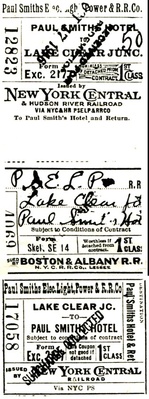 Tickets for the Paul Smiths Electric Railway. Adirondack Daily Enterprise December 12, 1987
Tickets for the Paul Smiths Electric Railway. Adirondack Daily Enterprise December 12, 1987 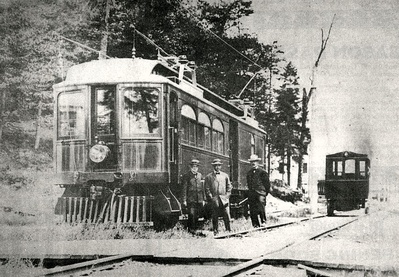 Paul Smiths Electric Railway car with (from left) Paul Smith, Sr., Paul Smith, Jr., and Phelps Smith, c. 1907. Adirondack Daily Enterprise December 12, 1987
Paul Smiths Electric Railway car with (from left) Paul Smith, Sr., Paul Smith, Jr., and Phelps Smith, c. 1907. Adirondack Daily Enterprise December 12, 1987  Steam Engines at Lake Clear Junction. Adirondack Daily Enterprise December 12, 1987
Steam Engines at Lake Clear Junction. Adirondack Daily Enterprise December 12, 1987  The 5200 volt power plant. Adirondack Daily Enterprise December 12, 1987 A logistical problem developed for Paul Smith’s Hotel as railroads began to penetrate the Adirondacks. By 1892, two stagecoaches and one tally-ho were responsible for connecting with up to 14 trains daily at three different railroads. Paul Smith decided to simplify the transportation by building his own railroad. The obvious choice for a connection was at Paul Smith’s Station in Gabriels, but the steep grade of Easy Street hill prohibited a railway. Paul selected Lake Clear Junction, the next closest point at seven miles. Construction began in 1905 with the use of two-second hand stream-powered locomotives. The railway opened for business on August 20th, 1906.
The 5200 volt power plant. Adirondack Daily Enterprise December 12, 1987 A logistical problem developed for Paul Smith’s Hotel as railroads began to penetrate the Adirondacks. By 1892, two stagecoaches and one tally-ho were responsible for connecting with up to 14 trains daily at three different railroads. Paul Smith decided to simplify the transportation by building his own railroad. The obvious choice for a connection was at Paul Smith’s Station in Gabriels, but the steep grade of Easy Street hill prohibited a railway. Paul selected Lake Clear Junction, the next closest point at seven miles. Construction began in 1905 with the use of two-second hand stream-powered locomotives. The railway opened for business on August 20th, 1906.
--(Corey Laxson, Paul Smith's College)
Adirondack Daily Enterprise December 12, 1987
Paul Smith builds a railroad
Paul Smith could never stand still. He refused, to rest on past accomplishments and his innovative mind was forever searching for a new approach to any business problem that might arise. He also possessed the courage to act without hesitation whenever his sharp intuition focused on a project.
And so it was in 1906 that he decided to build his own railroad which would be able to carry passengers from Lake Clear Junction to his hotel on Lower St. Regis Lake. He already owned an electric generating station at nearby Keese's Mills which he had converted from an existing water powered saw mill back in 1890. Since the power was available, he elected to operate on electricity rather than steam.
Over the years Paul had been running stagecoach lines to and from such railheads as AuSable Forks, Brandon and Bloomingdale to carry his hotel guests back and forth. When the railroad was extended south from Malone in 1892, it passed within four miles of the hotel which made it the nearest point for the transfer of rail passengers to a Paul Smith's stage coach. At the crossing of the Paul Smith's-Bloomingdale Road a station was built and, of course, it was named Paul Smith's Station. Fourteen years later, when the electric railway was built, the name of the station was changed to Gabriels. Paul had donated the adjacent lands to the Catholic Sisters of Mercy for the construction of Gabriels Sanitarium and the good Sisters named the hospital for Bishop Henry Gabriels of the Diocese of Ogdensburg. Although this location was nearer to the hotel, by some three miles, than the distance to Lake Clear Junction, an engineering study had proved the Easy Street Hill to be too steep a grade for any railroad construction. The seven-mile route from Lake Clear was fairly level and Paul owned all the land. Where it was necessary to make cuts the removed spoil could be used as fill in the swampy areas.
Steam locomotive
Construction of the roadbed, by necessity, had to begin at the southern terminal where the heavy equipment could be moved by rail. Paul purchased a steam locomotive from New York Central to serve as the workhorse during the laying of the rails. Just north of the Lake Clear Junction, where the line swung around Johnson Hill, a construction camp was built which was nicknamed "Woodpecker Inn." No doubt there were several versions of "I've Been Working on the Railroad" sung nightly by the boys on the crew. Even though the iron horse was present, a great deal of manual labor was required in the grading and the placement of the wooden ties. The work progressed rapidly and by August of 1906 the line was in service. By this time Paul had purchased another steam locomotive and, until the line could be built to supply electric power and an electric car could be built to a special design, the railroad would be steam operated.
According to an article in the 1976 issue of the "Franklin Historical Review," written by Professor Mike Kudish of Paul Smith's College, the car was built by the J.C. Brill Co. of Philadelphia and the electric equipment was installed by the Genera Electric Co. of Schenectady. Apparently the car was delivered toward the end of the year in 1906.
Since the line voltage from his Keese's Mills plant was 5,200, Paul had ordered the drive motor design to operate at that voltage. The 5,200 V. power received from the trolley was was converted to 600 V. direct current by a motor-generator set within the car. There was a trolley pole at each end of the car, one for northbound travel and one for the southbound trip. As there was no roundtable or method to turn the car around, all loads were pushed to the hotel and pulled to Lake Clear. Painted on the sides of the car where all could see was: Paul Smith's Electric Railway — St. Regis and Osgood Chain of Lakes - U.S. Mail.
Many of the wealthy camp owners had their own private parlor cars so a siding was built at the hotel for the express purpose of providing a parking area. A millionaire city dweller could embark in the privacy of his luxuriously equipped car which, upon arrival at Lake Clear Junction, would be switched to the Paul Smith trolley for the final leg of the journey. This arrangement allowed the occupant of the private cars to enjoy all of the travel comforts without having to change trains en route. Upon arrival at the hotel siding, the party could vacation at Paul's hostelry or depart in a waiting launch to reach one of the ornate camps on the chain of lakes.
Full fare of 50 cents
The seven-mile ride from Lake Clear to Paul Smiths usually required a half hour so the average rate of speed for the one-way trip was 14 miles per hour. The full fare was 50 cents with a half fare ticket from Martin's Crossing or Coal Brook Camp at 25 cents each. A trip report was made daily signed by both the conductor and the motorman which listed such statistics as number of trips, car hours steam, and car hours electric. July of 1910 might represent an average month's income from passenger service with a total number of tickets sold reaching 1,020 and an income figure of $502.25. The conductor at that time was Fred Lamaro and the motorman was W.H. Brown. Over the years there were many other operators of the car such as John Reome, Ernest Leffler, Albert Claremont, W.H. Currier, George Lathrop, J. Fitzpatrick, and Dan Murphy. A trip ticket for March 1st, 1918 represents the slack season with only one half fare from Martin's Crossing and three half fares from Coal Spring Camp. A deduction of 12 cents represented the war tax of World War I. Many discharged soldiers returning home to the Paul Smiths area after the war had their final rail ride aboard the electric car. Dr. E.L. Trudeau was a frequent passenger when traveling between his home in Saranac Lake and the hotel where he chose to summer on Lower St. Regis Lake.
Hauling logs
The hauling of passengers and parlor cars was not the only business which Paul managed over his railroad. The electric engine was capable of hauling flat cars loaded with logs or lumber from the hotel mill. In the winter a snow plow was mounted on the engine to clear the tracks and sidings for the pick up of logs from the surrounding woods when the timber was more plentiful than passengers. Apparently the lumber mills provided the only appreciable amounts of freight from the area with only light freight arriving at the Paul Smith terminal. For the month of October 1910, the president of the Paul Smiths electric railroad was only $83.34. Adirondack Daily Enterprise December 12, 1987
For the month of October 1910, the president of the Paul Smiths electric railroad was only $83.34. Adirondack Daily Enterprise December 12, 1987
Quick service
A service schedule of 1906 advertised through Pullman service direct to Paul Smith's Hotel with five connections daily by way of New York Central Lines at Lake Clear Junction. By leaving New York City at 7:50 a.m. one could reach Albany at 11:18 a.m., Utica at 1:45 p.m. and arrive at the hotel at 7:35 p.m. An overnight trip would leave New York, at 7:30 p.m. and arrive at Paul Smith's at 7:05 on the following morning. By sleeping on a Pullman no day was lost in travel.
After enjoying some twenty years of operation the Paul Smith's Electric Railway was showing signs of decline. The impact of the family automobile was beginning to take its toll on the railroad's long reign.
Paul did not live to see it happen but by 1928 a new fuel had been introduced to his rail line along with steam and electricity with the addition of a gasoline engine. The trip report for July llth, 1928 shows car hours electric - 3, and car hours gas - 9, which would indicate usage of gas a three-to-one favorite over electric for economy of operation. It was obvious that with very few customers using the facility it would be impractical to energize the huge electric motor any longer. The gas powered car continued to run until 1930 and nine or ten years later the tracks were removed thus ending that historic era of the Paul Smith's Electric Railway.
In May of 1976 Mike Kudish was still able to trace the old roadbed and as he walked the seven miles from Paul Smith's to Lake Clear, he managed to salvage some artifacts for the museum being currently formed at the college.
 The railway opened for business on August 20th, 1906. The photo below shows Paul Smith’s and some hotel guests during the inaugural year of the train. Notice the hastily laid tracks, as well as the lack of adequate ties and a bumper on the left side of the photo. The railway was electrified, although the electric car and appropriate infrastructure was not in place until 1907. Careful examination of the photo reveals a steam engine at the far right.
The railway opened for business on August 20th, 1906. The photo below shows Paul Smith’s and some hotel guests during the inaugural year of the train. Notice the hastily laid tracks, as well as the lack of adequate ties and a bumper on the left side of the photo. The railway was electrified, although the electric car and appropriate infrastructure was not in place until 1907. Careful examination of the photo reveals a steam engine at the far right.
Courtesy of Corey Laxson and Paul Smith's College Archives.Paul Smith was extremely proud of what some wags called his "Toonerville Trolley," and he took great delight in riding over the line. It was a common practice at that time for ranking officers of major railroads to exchange courtesy passes for use in personal travel. Paul wrote a letter to one of the major lines suggesting a swap of passes. The reply was not favorable stating that their line was several hundred miles long while Paul's was a mere seven. Paul fired right back by claiming "your line might be longer but mine is just as wide!" He got the pass.
Plattsburgh Daily Press, June 10, 1904
Electric Road to Paul Smith's.
The survey of the electric railroad to run from Lake Clear Junction to Paul Smith's Hotel will be completed this week. The grade is found to be much less than first anticipated by the engineers. A standard gauge road will be laid at once and the sleeping cars of the New York Central & Hudson River railroad will run directly to the hotel, also all the freight for the house and its store will be taken in the same run. The handling of the freight to the house in a year is a very big item in its running expenses. It now costs about $15 per car to draw freight from the N. Y. C. station to the hotel, a distance of four miles, and an average of one hundred cars a year are drawn over the road for Smith. This expense will be cut down to a fifth when the electric road is in operation. This fall the managers intend to extend the road through to the lumber mill, and the great timber lands of the Smith's will be lumbered.
Malone Palladium, July 11, 1907
Highways of the Adirondacks.
Already Paul Smith has placed in operation a trolley road of seven miles in length, connecting his hotel on Lower St. Regis Lake with the main line of the Adirondack Branch of the New York Central road at Lake Clear Junction. This road will be an addition either for its own right of way or through connections with the New York Central to Saranac Lake and Lake Placid. A trolley road will be built through the streets of the Adirondack metropolis within the next two years. This road will be extended to Lake Placid, and thence easterly through the wooded ridges of the Adirondacks to the shores o| Lake Champlain. The surveys have been completed, much of the right of way obtained, and there is little opposition to the granting of the franchise.
 Looking north from Lake Clear Junction, Paul Smiths electric railroad tracks are on the left, with the overhead wires barely visible here. Undated.
Looking north from Lake Clear Junction, Paul Smiths electric railroad tracks are on the left, with the overhead wires barely visible here. Undated.
Courtesy of Doug Vensel and the NEW Adirondack RR - North Operation Facebook group.
The most important of the railway projects now being considered is the electrification of the New York and Ottawa, which operates along the westerly margin of the Adirondack forest. The southern terminus of this road is now at Tupper Lake; originally it was planned to extend it through the Adirondacks southeasterly to North Creek, the terminus of a branch of the Delaware & Hudson and thereby make through connections with important eastern points. This, project was never carried out, owing to the fact that the railroad can not cross the State lands intervening. This road is now a part of the. New York Central system, and in connection with Paul Smith's road it is believed by railroad men that several miles of track may be saved and facilities in transporting freight and passengers improved by cutting a line of the New York & Ottawa at Brandon and running the tracks easterly along the St. Regis River to Paul Smiths and Lake Clear Junction.
Negotiations have been opened to obtain the right of way through Paul Smith's Park, but the danger of forest fires from the locomotives is one of the obstacles in the way of obtaining the necessary consent to cross Paul Smith's Park. The frequency of water powers along the St. Regis River, and the developments of the power of the Saranac River, will provide for the change of motive power on the New York & Ottawa from steam to electricity, and this important development is expected within the next two years.
A great amount of money has been expended this year in the construction and improvement of the highways connecting Paul Smiths, Loon Lake, Saranacs, Lake Placid, Elizabethtown and the valleys of the Ausable and Racquet Rivera.—N. Y. Times
Brighton History Days: Paul Smith's Electric Railroad
When Paul Smith's Hotel was at its peak of popularity in the 1890's, it could be reached via three different railroads. The stations were at Brandon (8 miles), Bloomingdale (7 miles), and Gabriels (3 miles). The Hotel met all trains at the stops (up to 14 daily) with stage coaches.
To improve service Paul Smith conceived the idea of building a branch railroad between the nearby mainline and the Hotel. Although Gabriels was the closest connection, the steep hill at Easy Street made this route impractical. In 1904 Smith had M.J. Corbett make a survey and a line was located through to Lake Clear Junction, seven miles to the south. This route was almost level and since the Paul Smith's Electric Light and Power and Railroad Company already provided electricity to the Hotel complex, it was decided to power the new railroad electrically.
An electric interurban combine car was ordered from Philadelphia with motors and electrical equipment from General Electric in Schenectady. The car was named “The St. Regis and Osgood Chain of Lakes” and was divided with one end for baggage and mail with the other for up to 24 passengers. The car cost $25,000 and the entire railroad $75,000.
Construction of the line took place in 1905 and 1906, with service beginning on August 20, 1906. All trains on the New York Central were met at Lake Clear Junction (five each day except Sunday) with 30 minutes allowed for the seven mile run. With the new service available, stage coach service to the other three stations (Brandon, Bloomingdale and Gabriels) was discontinued.
There was no turntable or wye to use to reverse the direction of the electric car so it always headed the same way, the mail baggage end towards Lake Clear Junction. Freight and passenger cars (including Pullman sleepers and private cars) also used the track, being pushed to the Hotel and pulled back to Lake Clear Junction.
The railroad closed in 1932 but the rails remained until the beginning of World War II. After the closing the electric car was stripped of all valuable material. The shell of the car stood in the open on the Paul Smiths College campus until 1984 when it was destroyed due to extensive deterioration.
Sources:
- Harter, Henry A. Fairytale Railroad.
- Kudish, Michael, Where Did the Tracks Go?
- Desormo, Maitland, Heyday of the Adirondacks.
Brighton History Days have been held one weekend each summer since 1994, sponsored by the Brighton Architectural Heritage Committee.
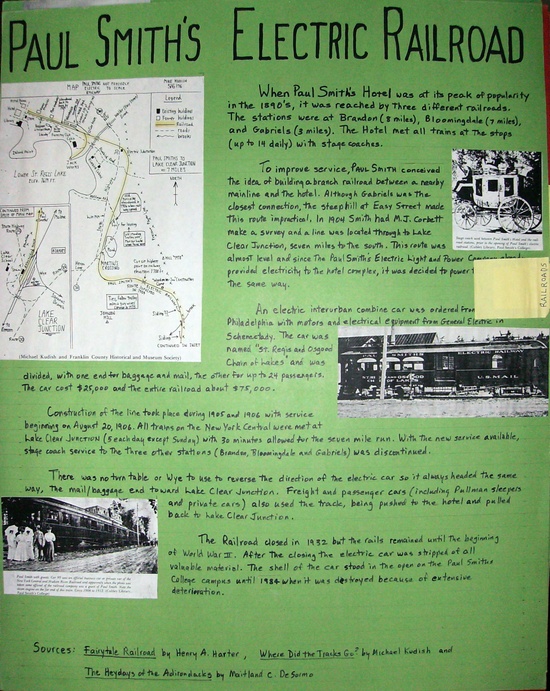 "Paul Smith's Electric Railroad" by Pat and Tom Willis, photo of display taken 2/2009.
"Paul Smith's Electric Railroad" by Pat and Tom Willis, photo of display taken 2/2009.
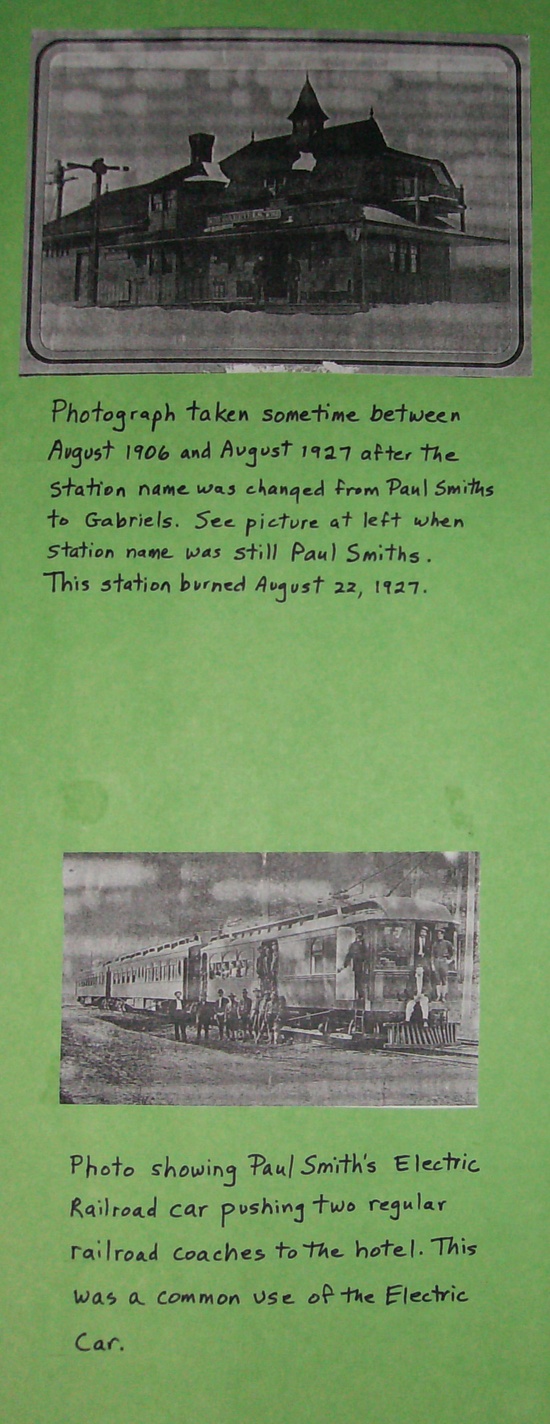 "Paul Smith's Electric Railroad, Continued" by Pat and Tom Willis, photo of display taken 2/2009.
"Paul Smith's Electric Railroad, Continued" by Pat and Tom Willis, photo of display taken 2/2009.
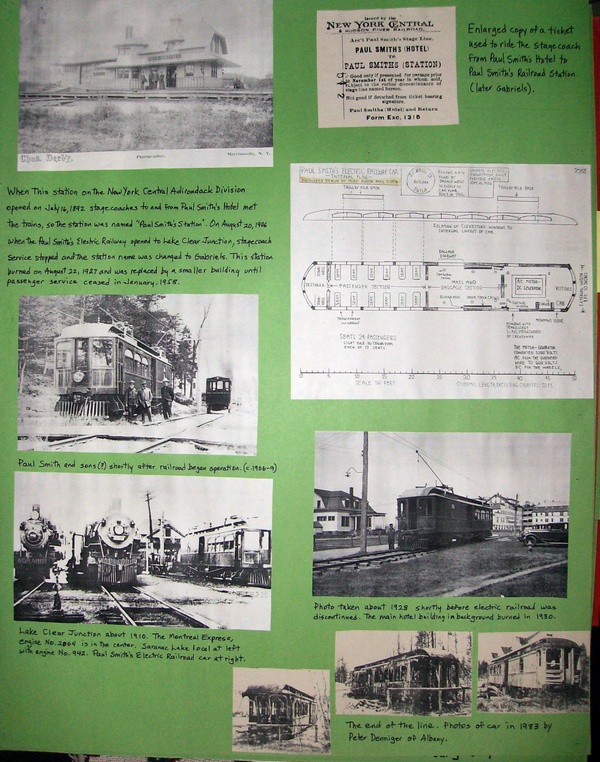 "Paul Smith's Electric Railroad, Continued" by Pat and Tom Willis, photo of display taken 2/2009.
"Paul Smith's Electric Railroad, Continued" by Pat and Tom Willis, photo of display taken 2/2009.
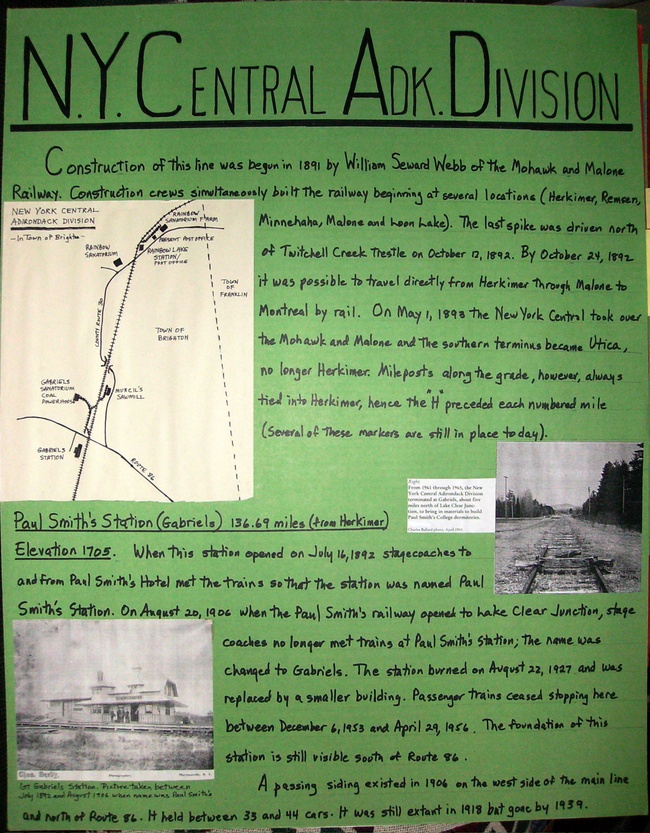 "New York Central Railroad" by Pat and Tom Willis, photo of display taken 2/2009.
"New York Central Railroad" by Pat and Tom Willis, photo of display taken 2/2009.



